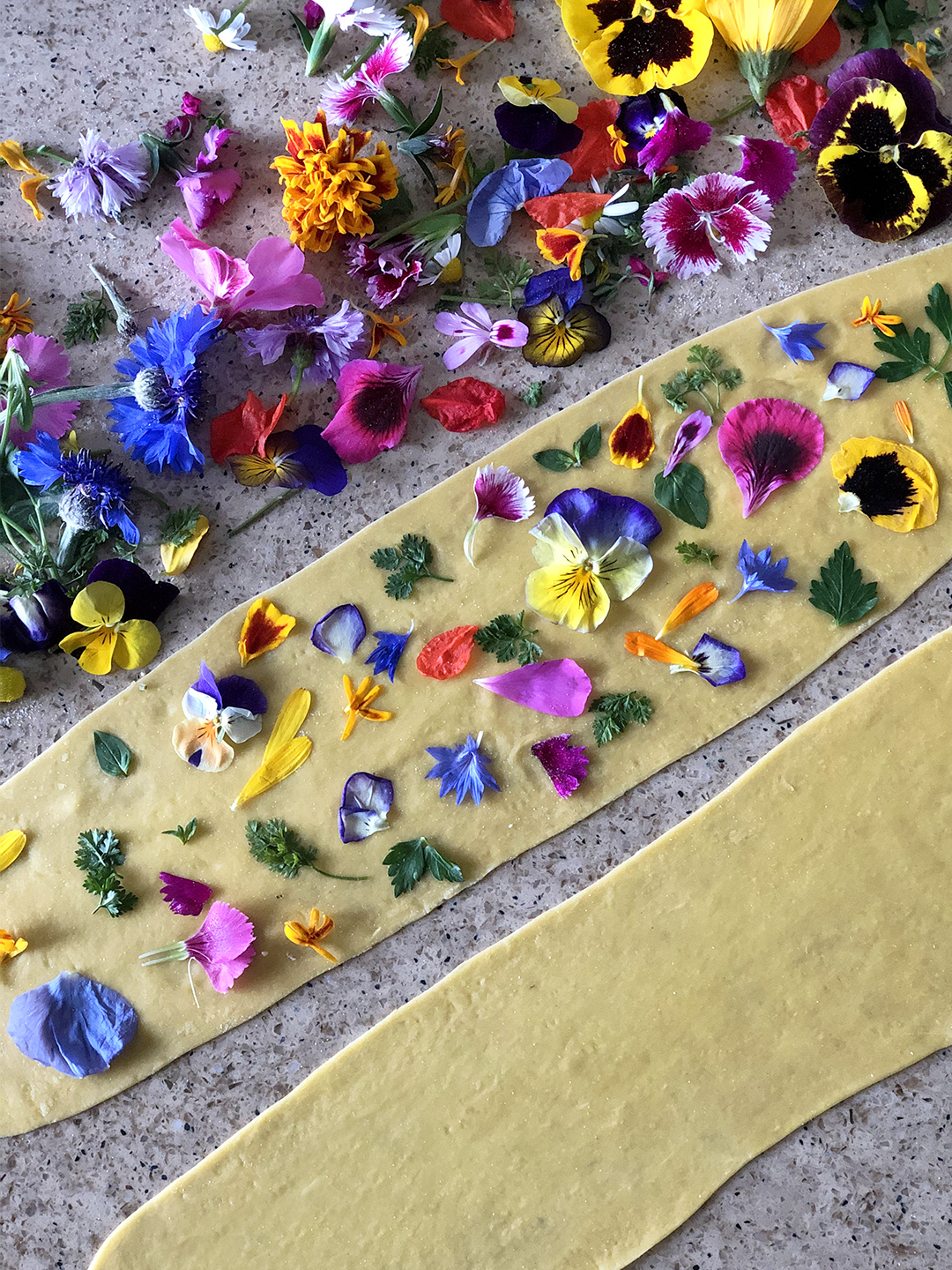We may earn revenue from the products available on this page and participate in affiliate programs.
Home should be your happy place—now more than ever. Head to the #MakeYourselfAtHome hub to find tiny projects, feel-good recipes, and clever decorating ideas to make each day a little bit brighter.
For some, it’s bread. For others, it’s whipping up fancy dinners for one. So many of us are turning to cooking as a form of therapy right now, and if your particular brand of comfort involves a giant bowl of pasta, we have an idea to help you kick it up a notch: Why not add flowers?
This idea comes courtesy of chef (and flower-pressed cookie pioneer) Loria Stern. The florals in her recipe are all edible—she typically gets them from farmers’ markets and her own backyard, but you can buy them online, too—and are a small but meaningful way to very literally brighten up your plate. “It’s so magical to see them press and stretch into the dough,” says Stern. If you can’t get your hands on lemon-colored violas, she recommends subbing in whatever you have in your fridge: any combination of fresh herbs (for example, sage, thyme and parsley) and even carrot tops will work well.
It’s a bit more laborious than your average meal, sure, but that’s the point. Carve out an afternoon and take time to roll out the dough, individually sprinkling on the multicolored petals. There’s something luxurious about a slow recipe like this; the only thing you’ll have to worry about is what to serve it with. For the record, Stern loves a brown butter sauce with slivered garlic and some lemon zest.

The Ingredients (serves 2)
- 1 ¼ cups all-purpose flour
- 2 eggs
- 1 tsp olive oil
- Edible flowers and herbs, to taste
- Pasta machine (Stern uses KitchenAid’s pasta attachment)
- Rolling pin
- Extra flour
- To boil: 8 cups water, 2 tbsp kosher salt (the winning formula: 1 tbsp salt for every 4 cups of water)
Step 1: Mix Everything Together
Pour your measured flour onto a work board or countertop. Make a well in the middle of the flour, and add the eggs and olive oil. Beat them carefully with a fork, slowly incorporating the flour from the sides of the well inward, until you have a mass.
Step 2: Work Dough Into a Ball
At this point you can ditch the fork and start using your hands to knead the dough until smooth. If it sticks to your hands, add a little more flour. The process takes a while, so be patient—you can listen to Stern’s favorite pasta-making playlist here.
Once it’s done and formed into a ball, set it aside under a cloth for 30 minutes to an hour. While it’s resting, start picking apart your petals and herbs.
Step 3: Form the Pasta
Cut the dough into three portions. Set aside two of those under the cloth, and begin flattening out the first with a rolling pin until it’s thin enough to feed into your pasta machine at the lowest/thickest setting. Pass it through the machine once, fold it in half, and feed it though repeatedly until you have a rectangle shape. (Sprinkle lightly with flour so that the dough doesn’t stick to the metal, if needed.) Continue feeding the pasta through the machine, turning up the level until you reach the highest setting. If it becomes too long to handle, cut it in half; you’ll need two equal-length sheets for each portion.
Step 4: Arrange the Blooms
When you have your first two thin, long sheets of dough, stretch them on your work surface and start arranging your petals and herbs on top of the first one. Then carefully lay the second matching sheet on top—you can sprinkle a touch of water around the edges of each one to help them adhere together. Using your rolling pin, gently go over the sheets, pressing the flowers into the dough. Then pass the whole thing back through the machine on a slightly higher level until thin. Repeat the process with the rest of the dough.
Step 5: Prep the Pasta
To make the tagliatelle, liberally sprinkle flour on the dough and fold the pasta on top of itself a couple times. Then cut into strips. Separate them carefully, tossing with more flour to ensure they don’t stick together.
Boil a pot of salty water (“It should taste like the sea,” says Stern) and add the tagliatelle. You’ll know they’re done when they float to the top—this should take about one minute. Serve hot with your favorite sauce, and enjoy!
See more recipes we’re making this week: How to Make Dinner With What’s in Your Freezer What Chefs Make When They Don’t Have Time to Grocery Shop Cooking for One Doesn’t Have to Be the Worst




